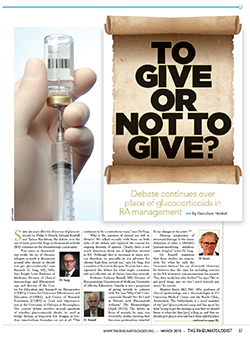Glucocorticoids: The Debate Continues
Déjà vu … In past decades, rheumatologists have seen, heard, practiced and taught much of what has been argued in the “ongoing debate” on the use of glucocorticoids (GCs) in the management of rheumatoid arthritis (RA).1 It is heartening to note that eminent professors have stuck to their premise all these years, as have I for decades (see “To Give or Not to Give? Debate continues over place of glucocorticoids in RA management,” The Rheumatologist, March 2015).
Having worked in India for most of my professional career, I may add to the confusion. Asian Indians as a race do not tolerate GCs well. The reason could possibly be that Asian Indians are highly prone to metabolic syndrome.2,3 Given even in small daily doses, GCs have adverse effects, mostly related to the metabolic syndrome.
Poverty is the second related issue. This puts biologicals out of reach for most. Therefore, in India we mostly use DMARD combos with bridging therapy, by way of depot-GC injections or orally for a short term. However, this creates problems. Because GCs are the cheapest and the most powerful pain reliever, the patient quickly perceives this as the real drug. With inherent difficulties in travel to reach a rheumatologist (e.g., poor facilities for differently abled persons in India) and the involved expense, they fall back on the magic pill! These are kept for handy use and popped frequently without recourse to further medical advice. Over time, as the GC dose becomes less effective, they often simply increase the dose on their own. It’s important to note that in India, most drugs, especially GCs, can be obtained over the counter without prescription. The appearance of such patients when they finally decide to return to the rheumatologist after a gap of five years or so for further treatment is familiar to rheumatologists, especially of my generation: what we used to call a steroid wreck—an obese, wheelchair-bound, semi-blind person with advanced Cushingoid features, extensive steroid purpura, some healed and some not-so-well-healed fractures, diabetes and hypertension, along with advanced joint damage and deformities.

After dealing with such patients for 47 years, I have two important take-home lessons. First, pharmaceutical companies should change the taste: Prednisolone tablets are easy on the palate. If a GC pill were extremely bitter, it might discourage casual popping, as people do with gum or candy, whenever there is pain. Methylprednisolone (MP) is such a tablet. In addition to being more expensive, it tastes horrible, so bitter that patients plead with me not to prescribe it. So I started substituting MP for prednisolone.
Second, low-dose-methotrexate (LD-MTX) intolerance was becoming a major problem above the 15 mg/week dose. From oncology colleagues, we learned that a moderate dose of GC prior to chemotherapy prevents nausea and other unpleasant sensations of chemotherapy. We started giving MP, varying from 4 to 16 mg weekly about 30 minutes before the LD-MTX dose. Whether it prevented or reduced LD-MTX intolerance was not studied systematically, but unexpectedly it was noted, on withdrawing the weekly MP dose, that several patients soon returned, complaining of increased pain and/or swelling in the joints. We then systematically analyzed patients who had been taken off the weekly MP dose. On reinitiating the weekly dose of MP, symptoms subsided quickly.
This work on 74 RA patients was presented at the annual meeting of the Indian Rheumatology Association in 2010.4 The patient group included 66 women (median age 49 years) with rheumatoid factor and ACPA positivity in 80% and 60%, respectively. The median disease duration was 76 months (range 19–300 months). They were under regular follow-up in the clinic. All of them were prescribed MP, varying from 4 to 16 mg/week, synchronized with LD-MTX weekly. The additional drugs included hydroxychloroquine, folic acid, calcium and vitamin D3. At the baseline, 60 patients (81%) had high or moderate disease activity (DAS28). In their follow-up, all the patients who had achieved remission or low disease activity state were advised to discontinue weekly MP doses. At that time, 65 patients (83.78%) were in remission, 12 patients (16.2%) were in low disease activity state and none had moderate or high disease activity. At follow-up after discontinuation of the weekly MP, 27 patients (36.49%) reported increased symptoms within a few weeks. Among them, 24 (88.8%) had objective joint swelling, with raised ESR and CRP in 13 (48%) and four (15%), respectively.
On reinitiating their original weekly MP dose, 21 patients (87.5%) again achieved remission or low disease activity. The three other patients required higher than their original weekly MP dose to achieve remission or low disease activity state. The routine monitoring for any adverse effects of this treatment, especially for markers of metabolic syndrome (e.g., blood glucose, lipid profile, hypertension) and DEXA-scans, did not show any significant change from the baseline levels.
I mentioned this work during my presentation at the 2013 ACR/ARHP Annual Meeting in San Diego with the warning that it was possibly based on a grade IV evidence and mostly experience and/or eminence (ACR Master observation) and should be used judiciously.5
If this raises more questions in this controversial field, I have succeeded!
Sincerely,
Anand N. Malaviya, MD, FRCP, Master-ACR
Department of Rheumatology
Indian Spinal Injuries Center
Vasant Kunj, New Delhi, India
References
- Henkel G. To give or not to give? Debate continues over place of glucocorticoids in RA management. The Rheumatologist. 2015 March;9(3):37–39.
- Enas EA, Mohan V, Deepa M, et al. The metabolic syndrome and dyslipidemia among Asian Indians: A population with high rates of diabetes and premature coronary artery disease. J Cardiometab Syndr. 2007 fall;2(4):267–275.
- Joshi SR, Parikh RM. India—Diabetes capital of the world: Now heading towards hypertension. J Assoc Physicians India. 2007 May;55: 323–324.
- Zaheer Q, Malaviya A, Negi P. Mini-pulses of methylprednisolone (MP-P) synchronised with weekly low dose methotrexate in the treatment of rheumatoid arthritis (RA): Could this be the best way to use glucocorticoids among Indian patients? Indian Rheumatology Association Annual Meeting 26th Iracon. Bhubaneswar, Oddisa; Poster presentation. 2010.
- Malaviya AN. ARHP Session C54: Rheumatoid arthritis management: Views from around the world. Conventional DMARDs or biologics: A developing world perspective. ACR/ARHP Annual Meeting. 2013 Oct 25–30.


